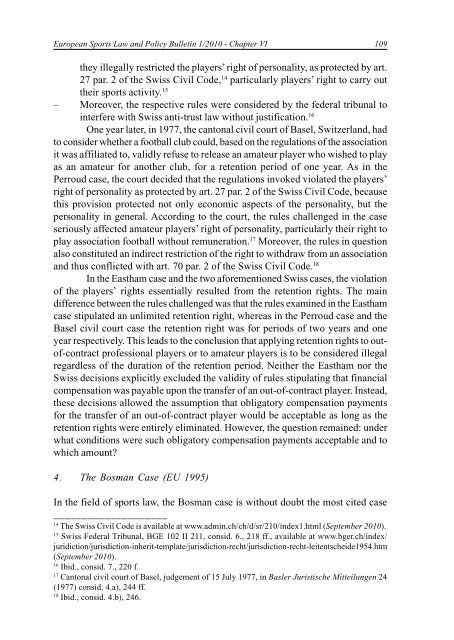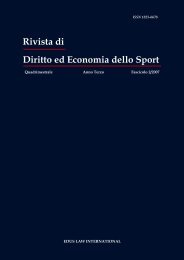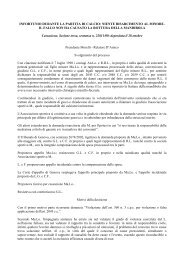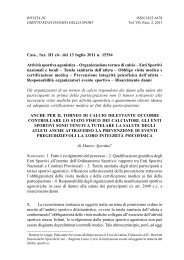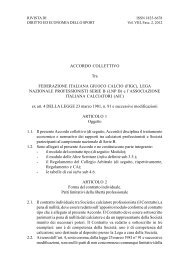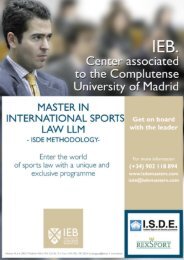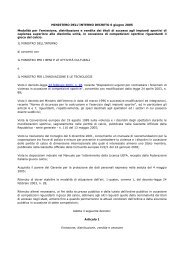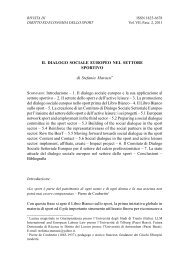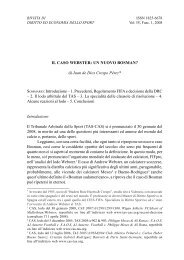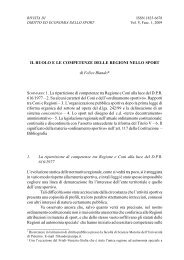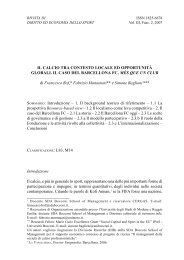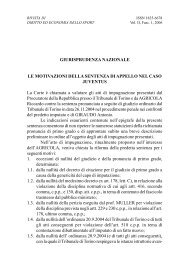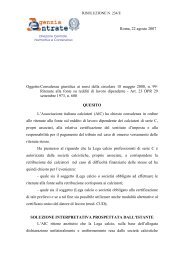European Sports Law and Policy Bulletin THE BERNARD ... - Slpc.eu
European Sports Law and Policy Bulletin THE BERNARD ... - Slpc.eu
European Sports Law and Policy Bulletin THE BERNARD ... - Slpc.eu
You also want an ePaper? Increase the reach of your titles
YUMPU automatically turns print PDFs into web optimized ePapers that Google loves.
<strong>European</strong> <strong>Sports</strong> <strong>Law</strong> <strong>and</strong> <strong>Policy</strong> <strong>Bulletin</strong> 1/2010 - Chapter VI 109they illegally restricted the players’ right of personality, as protected by art.27 par. 2 of the Swiss Civil Code, 14 particularly players’ right to carry outtheir sports activity. 15– Moreover, the respective rules were considered by the federal tribunal tointerfere with Swiss anti-trust law without justification. 16One year later, in 1977, the cantonal civil court of Basel, Switzerl<strong>and</strong>, hadto consider whether a football club could, based on the regulations of the associationit was affiliated to, validly refuse to release an amat<strong>eu</strong>r player who wished to playas an amat<strong>eu</strong>r for another club, for a retention period of one year. As in thePerroud case, the court decided that the regulations invoked violated the players’right of personality as protected by art. 27 par. 2 of the Swiss Civil Code, becausethis provision protected not only economic aspects of the personality, but thepersonality in general. According to the court, the rules challenged in the caseseriously affected amat<strong>eu</strong>r players’ right of personality, particularly their right toplay association football without remuneration. 17 Moreover, the rules in questionalso constituted an indirect restriction of the right to withdraw from an association<strong>and</strong> thus conflicted with art. 70 par. 2 of the Swiss Civil Code. 18In the Eastham case <strong>and</strong> the two aforementioned Swiss cases, the violationof the players’ rights essentially resulted from the retention rights. The maindifference between the rules challenged was that the rules examined in the Easthamcase stipulated an unlimited retention right, whereas in the Perroud case <strong>and</strong> theBasel civil court case the retention right was for periods of two years <strong>and</strong> oneyear respectively. This leads to the conclusion that applying retention rights to outof-contractprofessional players or to amat<strong>eu</strong>r players is to be considered illegalregardless of the duration of the retention period. Neither the Eastham nor theSwiss decisions explicitly excluded the validity of rules stipulating that financialcompensation was payable upon the transfer of an out-of-contract player. Instead,these decisions allowed the assumption that obligatory compensation paymentsfor the transfer of an out-of-contract player would be acceptable as long as theretention rights were entirely eliminated. However, the question remained: underwhat conditions were such obligatory compensation payments acceptable <strong>and</strong> towhich amount?4. The Bosman Case (EU 1995)In the field of sports law, the Bosman case is without doubt the most cited case____________________14The Swiss Civil Code is available at www.admin.ch/ch/d/sr/210/index1.html (September 2010).15Swiss Federal Tribunal, BGE 102 II 211, consid. 6., 218 ff., available at www.bger.ch/index/juridiction/jurisdiction-inherit-template/jurisdiction-recht/jurisdiction-recht-leitentscheide1954.htm(September 2010).16Ibid., consid. 7., 220 f.17Cantonal civil court of Basel, judgement of 15 July 1977, in Basler Juristische Mitteilungen 24(1977) consid. 4.a), 244 ff.18Ibid., consid. 4.b), 246.


